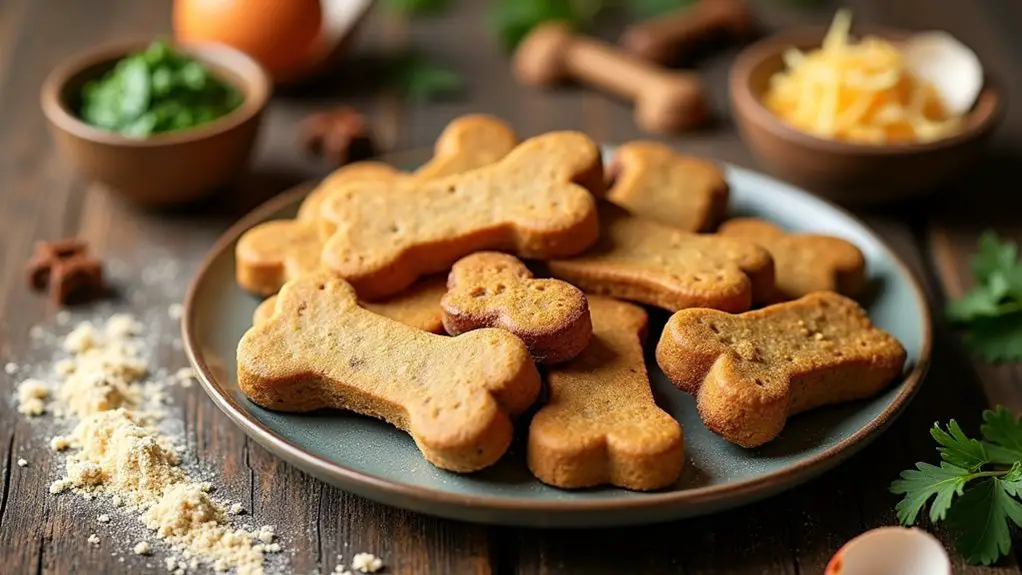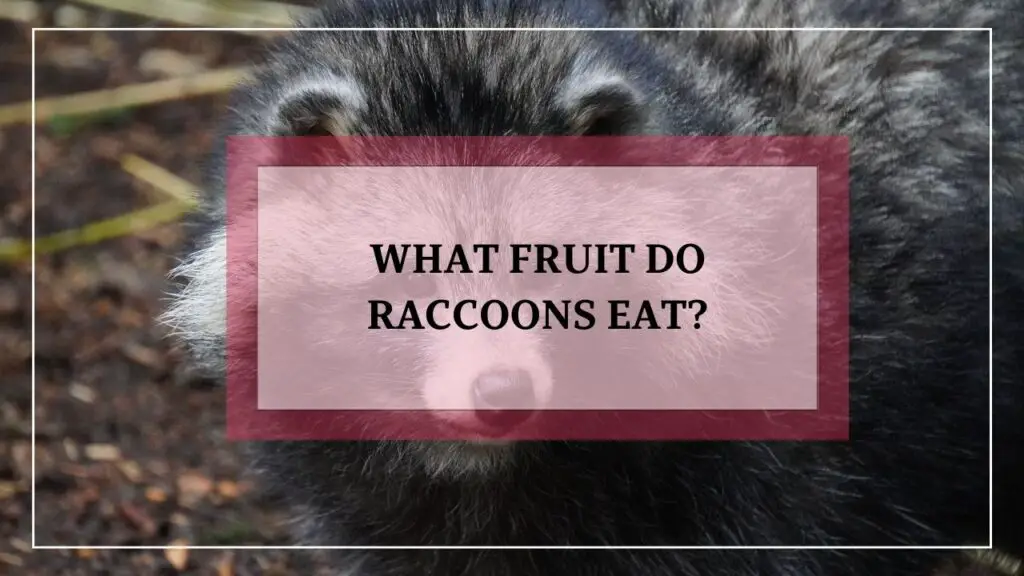Have you ever wanted to treat your pup with something special but felt overwhelmed by complicated recipes? Well, homemade peanut butter and banana dog treats are as easy as pie—well, easier actually. Just imagine your dog’s tail wagging with joy as they taste these yummy bites. Plus, you’ve got whole grains and wholesome ingredients working for you. Stick around to find out how to whip these up and maybe save yourself a trip to the pet store.
Why Homemade?
When it comes to treating your furry friend, you might wonder why you’d bother making these homemade peanut butter and banana dog treats instead of just grabbing a bag from the store. Well, it’s all about control—control of ingredients, to be precise. You wouldn’t want your pup munching on mystery additives, right?
With your homemade treats, you know exactly what’s in them: natural peanut butter, ripe bananas, and a touch of love. Plus, let’s face it, your dog can spot a homemade treat from a mile away. The excitement they show is priceless.
Imagine the tail wags and happy barks when you whip out those fresh peanut butter banana dog treats. It’s not just about the taste; it’s an emotional connection, too.
And hey, if you make a mess in the kitchen, just think of it as bonding time with your furry sous-chef!
Variety of Treat Recipes
You’ve got options, and trust me, your furry friend will thank you for all the tasty treats you can whip up at home.
From Peanut Butter Banana Bites to Sweet Potato Crunchy Bites, each recipe brings something unique to the bowl. Isn’t it fun to mix it up in the kitchen and see what your pup loves most?
1. Peanut Butter Banana Bites
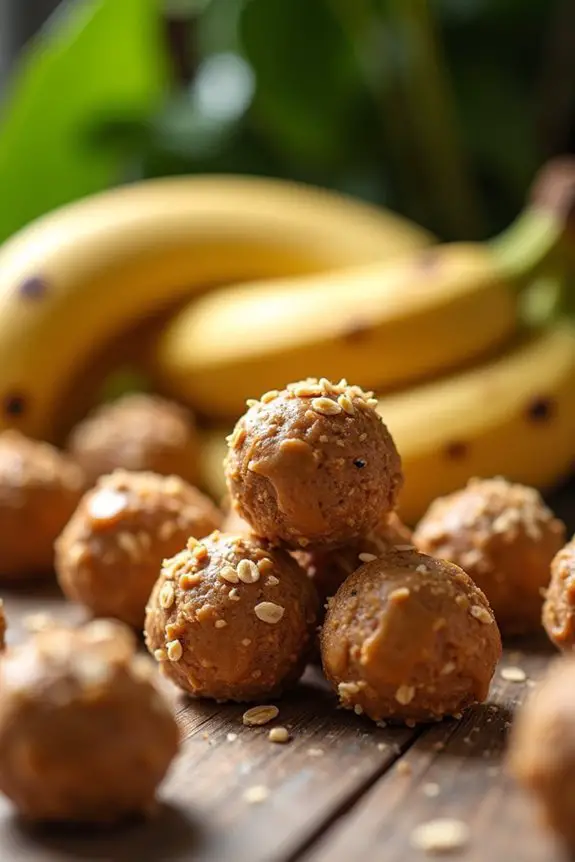
When it comes to making Peanut Butter Banana Bites, you’ll want to gather some simple ingredients that your pup will drool over. From creamy peanut butter to ripe bananas, each step is easy and rewarding. And hey, if you’re feeling adventurous, you can even throw in some optional add-ons to really impress your furry friend. To take your treats to the next level, consider pairing them with luxury dog food that caters specifically to your Chihuahua’s dietary needs.
Ingredients
Who can resist the smell of freshly baked treats? Especially when they’re for our four-legged friends. Making peanut butter and banana dog treats at home isn’t just rewarding; it’s also super simple when you know what to grab from your kitchen. Here’s what you’ll need to get started on this tail-wagging recipe:
- 1 ripe banana, mashed (the browner, the better)
- 1 cup peanut butter (make sure it’s xylitol-free)
- 1 ½ cups whole wheat flour (or oat flour if your pup has wheat sensitivities)
- 1/4 cup rolled oats
- 1 egg (optional, but can help with binding)
- 1/4 cup water (adjust as needed for dough consistency)
Gather these ingredients, and you’re already halfway to some happy barks and wagging tails. Just picture the joy in their eyes when they get a taste of these delicious bites. Let’s get baking!
Step by Step Instructions
- Preheat your oven to 350°F (175°C). This cozy temperature will make your kitchen smell like a treat-making paradise.
- In a mixing bowl, combine 1 ripe mashed banana with 1 cup of peanut butter. Use a fork to mash the banana smoothly, ensuring there are no chunky surprises.
- Add in 2 cups of whole wheat flour. Mix it all together until combined (Don’t worry if it looks a bit thick; that’s what we’re going for).
- If you like, add a ¼ cup of oats for some added texture. Fold them in gently, just until incorporated (because we don’t want it to be an oat explosion).
- Take a baking sheet and line it with parchment paper. This handy little mat will keep your treats from sticking, making cleanup a breeze.
- Roll the dough into small balls, roughly the size of a tablespoon, and place them on the prepared baking sheet. Give them some space to breathe – no crowding here.
- Press each ball down gently with a fork to create a crisscross pattern. This gives them a cute look and helps them bake evenly.
- Bake for 25–30 minutes, or until they turn golden brown and your kitchen smells like the best dog bakery ever. (And let’s not lie, you might want to sneak a bite yourself).
- Once they’re done, remove them from the oven and let them cool on the baking sheet for a few minutes before moving them to a wire rack.
- Cool completely before serving to your dog. They’ll be wagging their tail in delight, and honestly, what more could you ask for?
Optional Add-ons
Looking to spice things up in your dog’s treat routine?
Why not try adding a dash of cinnamon or a spoonful of pumpkin puree to your peanut butter banana bites?
You could even toss in some oats for extra crunch.
Your pup won’t know what hit ‘em.
Experimenting can lead to tail wags and a happy dancing dog.
It’s a win-win!
2. Pumpkin and Oatmeal Treats
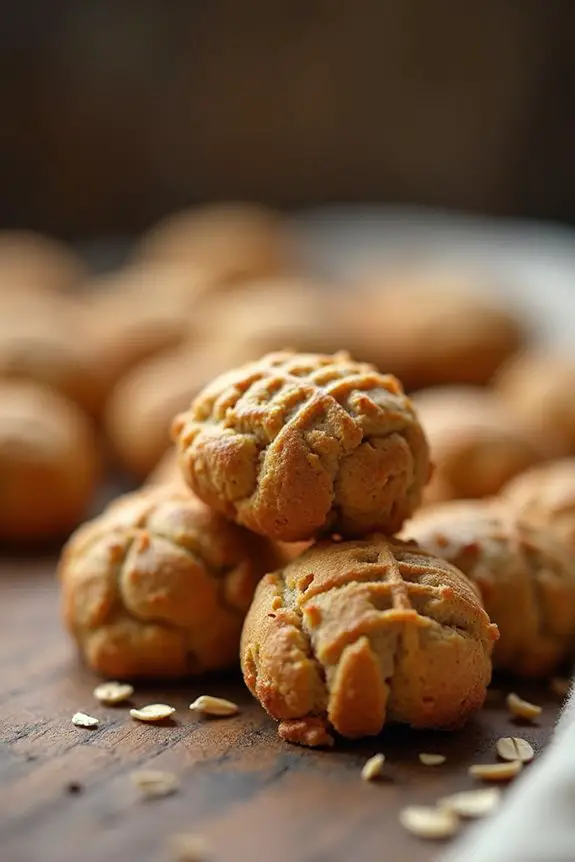
Now that you’ve tasted the delicious peanut butter banana treats, it’s time to switch it up with pumpkin and oatmeal goodies. Trust me, your pup will thank you when they catch a whiff of these irresistible smells filling your kitchen. Let’s gather some simple ingredients and go through each step, sprinkle in a few optional add-ons, and whip up a tasty snack that’s sure to impress! Moreover, consider enhancing your dog’s diet with premium dog food subscription options that provide balanced nutrition. Additionally, using premium dog food appliances can help you create fresh and healthy meals for your furry friend.
Ingredients
Making homemade dog treats is one of the best ways to show your furry friend just how much you care.
And the best part? You likely have many of these ingredients already tucked away in your pantry.
Let’s gather what you need for these delicious peanut butter and banana dog treats, which your pup is sure to love.
Don’t worry. Shopping for these is a walk in the park.
- 1 cup natural peanut butter (make sure it’s xylitol-free)
- 1 ripe banana, mashed
- 1 cup rolled oats
- 1/2 cup whole wheat flour (or oat flour for a gluten-free option)
- 1/4 cup water (add more if you need to get the right consistency)
Now, that’s it! Super simple, right?
With just these few ingredients, you’re already on your way to creating some tail-wagging goodness.
And if any of these items blurt out “kitchen superstar,” it’s definitely that peanut butter.
Just try to keep yourself from eating it all before it makes it into the bowl.
Trust me, I’ve been there, and my dog has given me some serious side-eye for it.
Step by Step Instructions
1. Preheat your oven to 350°F (175°C) to get things warmed up and cozy.
2. In a large mixing bowl, add 1 cup of pumpkin puree and 1 cup of rolled oats.
(Make sure it’s pure pumpkin, not pumpkin pie filling—trust me, it makes a big difference.)
3. Pour in 1/4 cup of peanut butter and 1/4 cup of water.
Mix it all together until it’s well combined.
(Don’t worry if it looks a bit sticky; that’s normal.)
4. Gradually add 1 cup of whole wheat flour to the mixture, stirring as you go.
(This is where it starts to get a little doughy, so don’t panic if it gets tough to mix.)
5. Use your hands to knead the dough lightly in the bowl until it’s smooth, about 1–2 minutes.
(There’s something oddly satisfying about getting your hands dirty.)
6. On a floured surface, roll out the dough to about 1/4 inch thick.
(Feel free to channel your inner chef—if you’ve got a rolling pin, this is your moment!)
7. Use cookie cutters to cut out shapes for your dog treats.
(Stars, bones, or whatever fun shape you want! Your dog won’t care, but you might enjoy a little holiday spirit.)
8. Place the cutouts on a baking sheet lined with parchment paper.
(Parchment paper is a game changer—trust me, clean-up is a breeze.)
9. Bake in the preheated oven for 25–30 minutes, or until they’re golden brown.
(Keep an eye on them; you don’t want rock-hard treats, but a little crunch is good.)
10. Remove the treats from the oven and let them cool on a wire rack.
(Just try not to munch on them yourself; as tempting as that may be.)
11. Cool completely before serving to your dog.
(Trust me, they’ll thank you with tail wags and puppy kisses.)
Optional Add-ons
While your pumpkin and banana dog treats are baking away, why not think about adding even more variety to your dog’s snack stash?
Oatmeal treats are easy to whip up. Just mix oats, pumpkin, and a splash of water.
Your pup won’t know what hit ’em! Trust me, it’s a win-win when their tails start wagging like crazy.
3. Carrot and Apple Chews
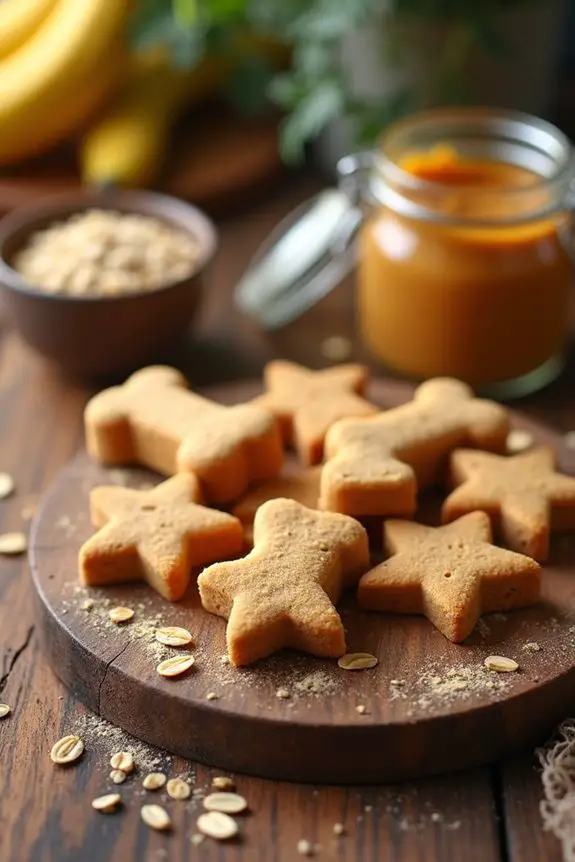
Now that you’ve made some tasty pumpkin and oatmeal treats, let’s switch gears to carrot and apple chews.
You’ll love how simple the ingredients are, and I promise your pup will wag their tail in approval. These peanut butter dog treats are an excellent way to add some variety to your dog’s snack time. Additionally, using high-quality dog training equipment premium can also enhance your dog’s learning experience. Stick around as I walk you through the step-by-step instructions and share some fun add-ons to make these treats even better.
Ingredients
Let’s get started on whipping up some delicious homemade treats for your furry friend!
These carrot and apple chews aren’t only easy to make but also super healthy for your pup. They’re a great option to keep those tails wagging.
So, here are the simple ingredients you’ll need.
- 1 cup grated carrots
- 1 cup unsweetened applesauce
- 2 cups whole wheat flour
- 1/2 cup rolled oats
- 1/4 cup peanut butter (make sure it’s dog-safe, no xylitol!)
- 1/4 cup water (or as needed for dough consistency)
You might already have some of these ingredients in your pantry, which is a win!
And if you’re like me, you might get a little excited shopping for dog treats, maybe even imagining how your dog will react the first time they try one.
Spoiler: They’ll probably go bananas for them!
Step by Step Instructions
1. Preheat your oven to 350°F (175°C). This will help your treats bake evenly and come out deliciously crunchy.
2. In a medium bowl, mix together 1 cup of grated carrots and 1 cup of finely chopped apples.
If you’ve got a picky pup, feel free to add in some mashed bananas for extra flavor (who can resist a banana?).
3. In another bowl, combine 1 cup of whole wheat flour, ½ cup of oats, and a pinch of cinnamon. Stir well to blend.
(You want to make sure there are no flour clumps lurking in there—smooth is the goal.)
4. Add in 1 large egg and ½ cup of unsweetened applesauce to the dry ingredients. Mix until just combined.
(Don’t overmix—the dough will be a bit sticky, and that’s okay.)
5. Fold the carrot and apple mixture into the dough. Keep mixing until everything is well incorporated, but remember, it’s fine if it looks a little rustic.
6. Lightly flour your work surface, and roll out the dough to about ¼ inch thickness.
(Try to keep it somewhat even so all your treats bake at the same time—nobody likes a sad, burnt snack.)
7. Use cookie cutters to shape your treats. Place them on a baking sheet lined with parchment paper, leaving some space between each treat.
8. Bake for 25–30 minutes or until they turn golden brown.
(That’s your cue that they’re ready—keep an eye on them unless you enjoy a smoke alarm symphony.)
9. Remove from the oven and let them cool on a wire rack.
Cool completely before serving to your dog; they’ll taste better that way, and you definitely want to avoid a hot treat burning that adorable tongue.
Optional Add-ons
While your homemade peanut butter and banana dog treats are sure to make your pup wiggle with joy, adding a twist with some carrot and apple chews can take snack time to the next level.
Just mix grated carrots and apple pieces into the dough, shaping them into fun forms.
Trust me, you’ll be the world’s best dog parent with these delicious additions.
4. Sweet Potato Crunchy Bites
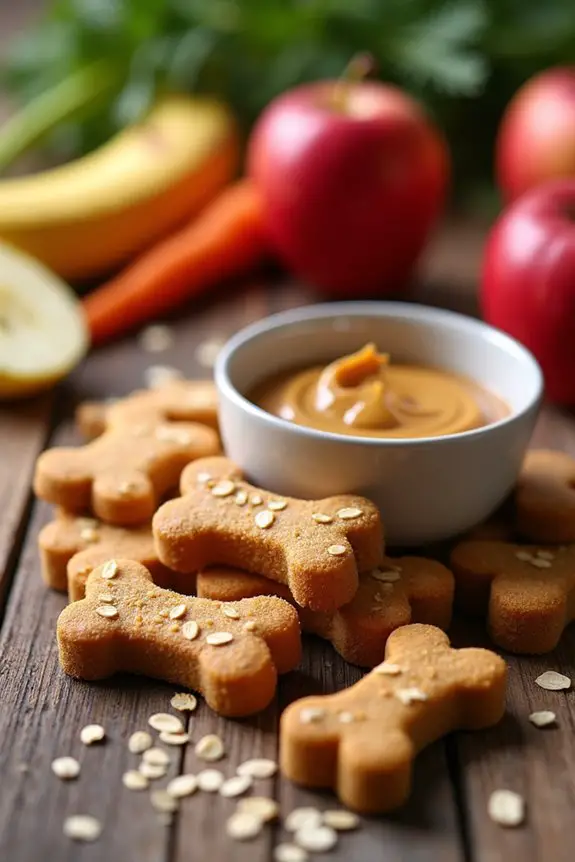
Now that you’ve mastered the Carrot and Apple Chews, let’s whip up some Sweet Potato Crunchy Bites. You’ll need just a few ingredients, and I promise it’s easier than convincing your pup to sit. Ready for step-by-step instructions and some fun optional add-ons to spice things up?
Ingredients
Making homemade dog treats is such a rewarding experience, and these Sweet Potato Crunchy Bites are sure to make your furry friend wag their tail in delight.
The combination of nutritious ingredients means you’re not just treating your pup, but you’re also giving them something wholesome.
Plus, it’s pretty much guilt-free for you too!
Here’s what you’ll need:
- 1 cup of cooked and mashed sweet potato (make sure it’s cooled)
- 2 cups of whole wheat flour (you can use oat flour for a gluten-free option)
- 1/2 cup of rolled oats (these will add a nice crunch)
- 1/4 cup of peanut butter (look for one that’s xylitol-free)
- 1/4 cup of chicken or beef broth (low sodium is best)
- 1 egg (medium-sized, preferably from a happy chicken)
- 1/2 teaspoon of cinnamon (a little spice never hurt, right?)
With these goodies in hand, you’re all set to whip up some tail-wagging treats!
Remember, your pup’s gonna think you’re the best chef in the world.
Just don’t let that go to your head—yet.
Step by Step Instructions
- Preheat your oven to 350°F (175°C) so it’s nice and hot when your treats are ready to bake.
- Gather your ingredients: you’ll need 1 cup of mashed sweet potato, 1 cup of whole wheat flour, 1/2 cup of peanut butter, and 1/4 cup of oats. Better not forget the peanut butter—your dog would never forgive you!
- In a large mixing bowl, mix together the mashed sweet potato and peanut butter until smooth and well combined. It should look like a yummy orange paste.
- Gradually fold in the whole wheat flour and oats. Make sure everything is mixed evenly (but don’t overmix—lumps are totally okay!).
- Roll the dough into small, bite-sized balls or use cookie cutters to create fun shapes. Whatever floats your boat. Don’t worry if they’re not perfect; your dog won’t notice.
- Place the shaped treats on a baking sheet lined with parchment paper, giving them some space to spread out a bit.
- Bake in the preheated oven for 25–30 minutes, or until they’re golden brown and firm to the touch. Your kitchen should smell like pure doggy heaven right about now.
- Let the treats cool on a wire rack before serving them to your furry friend. After all, nobody likes burnt tongues, right?
- Cool completely before serving to your dog. Trust me, the wait will be worth it when you see their wagging tail.
Optional Add-ons
If you want to take your dog treats up a notch, adding some optional ingredients can be a game-changer.
Ever thought about incorporating sweet potato? It’s not just tasty; it’s packed with nutrients.
Mash it up and mix it into your dough for crunchy bites that’ll have your pooch begging for more.
Trust me—your dog won’t know what hit ‘em.
5. Chewy Chicken and Rice Treats
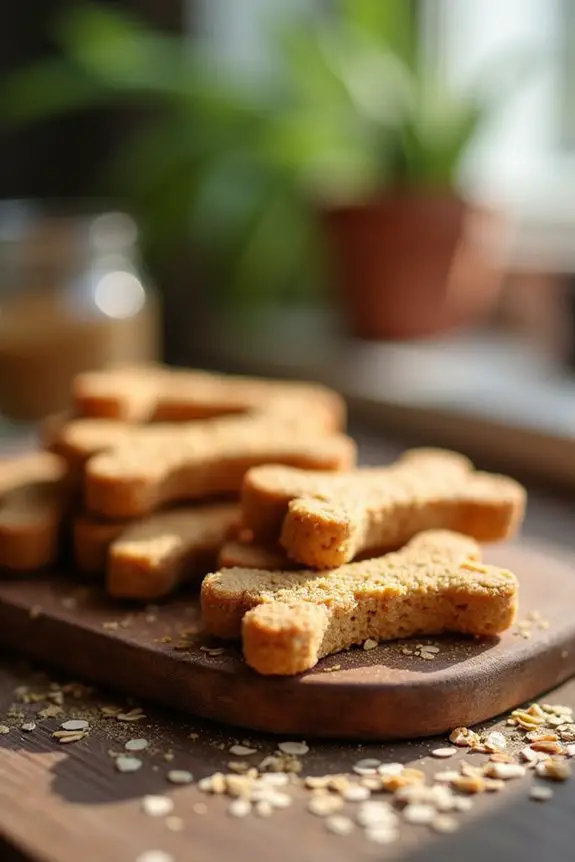
Now that we’ve crunched some sweet potato goodness, let’s shift gears to something a little heartier: Chewy Chicken and Rice Treats. Trust me, your pup’s tail will wag like crazy when they catch a whiff of these treats. We’ll walk through the ingredients you’ll need, step-by-step instructions, and even some fun add-ons to make them extra special; it’s easier than you think.
Ingredients
When it comes to whipping up some tasty treats for your furry friend, you really can’t go wrong with simple, wholesome ingredients. Plus, making homemade dog treats is a fun way to bond with your pup—you won’t believe their excited little face when they get a whiff of these goodies.
Nobody wants to spend all day at the store, so here’s a quick shopping list to make it easy-peasy. Let’s take a look at what you’ll need for those chewy chicken and rice treats that your dog will absolutely love:
- 1 cup cooked chicken, shredded
- 1 cup cooked brown rice
- 1/2 cup pumpkin puree (not pumpkin pie filling)
- 1/4 cup oats
- 1 egg
- 1 tablespoon chicken broth (low-sodium is best)
- Optional: 1/2 teaspoon parsley for fresh breath
These ingredients aren’t only safe but really good for your pup. Honestly, who could resist the delicious aroma wafting from the kitchen? Just thinking about it makes me want to bust out my own apron—although I might end up wearing more flour than I actually use.
Let’s get cooking, shall we?
Step by Step Instructions
1. Preheat your oven to 350°F (175°C). Trust me, we want those treats to bake up nicely.
2. Gather your ingredients: 1 cup of cooked chicken, ½ cup of cooked rice, ½ cup of peanut butter, and 1 egg. If you have a food processor, it’s your best friend here.
3. Mix the cooked chicken and cooked rice together in the food processor. Pulse until it’s combined but not completely smooth (you want some chunks for texture).
4. Add the peanut butter and egg to the chicken and rice mixture. Blend until it’s just combined (Don’t worry about perfection; this isn’t a baking contest).
5. Transfer the mixture to a mixing bowl. Slowly fold in 1 cup of whole wheat flour until the dough starts to come together.
If it’s too sticky, sprinkle in a little more flour, but don’t overdo it (aim for a manageable dough consistency).
6. Roll out the dough on a floured surface to about ½ inch thick. In this step, try not to make a flour explosion—trust me, it happens to the best of us.
7. Use cookie cutters to cut out shapes—or go freehand with a knife for squares if you’re feeling adventurous. It’s all about putting your own unique stamp on these treats.
8. Place the cut shapes onto a baking sheet lined with parchment paper. Make sure they’re spaced out a bit; they like their personal space.
9. Bake in the preheated oven for 20–25 minutes, until they’re golden brown. Keep an eye on them, as ovens can be quirky little things.
10. Once done, remove the treats from the oven and allow them to cool on a wire rack.
Cool completely before serving to your dog. Enjoy those tail wags and puppy kisses. You totally earned it.
Optional Add-ons
If you’re looking to spice up your dog’s snack game, these chewy chicken and rice treats are a fantastic option.
They’re simple to whip up—just mix cooked chicken, rice, and a dash of broth. Your pup’ll drool over the savory goodness.
And hey, if they get stuck to the floor, just blame it on the dog’s enthusiasm. It’s always an adventure.
6. Peanut Butter Pumpkin Bites
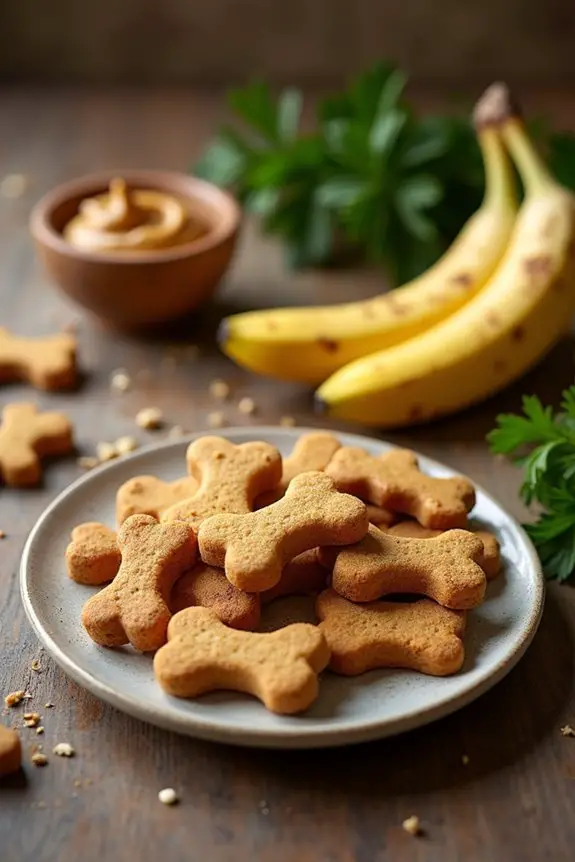
Let’s whip up some Peanut Butter Pumpkin Bites that’ll have your pup wagging their tail in delight. You’ll need just a few simple ingredients, and I promise, it’s easier than you think. Follow my step-by-step instructions, and feel free to throw in some optional add-ons to really spoil your furry friend!
Ingredients
Making these Peanut Butter Pumpkin Bites is a breeze, and your furry friend will be wagging their tail in excitement.
Let’s gather some easy ingredients that are safe and healthy for your dog.
- 1 cup of natural peanut butter (make sure it doesn’t have xylitol)
- 2 cups of whole wheat flour
- 1/2 cup of canned pumpkin (not the spiced pie filling, just pure pumpkin)
- 1/4 cup of rolled oats
- 1 egg
- A splash of water (just enough to get the dough right)
And there you have it! Simple, right?
These ingredients don’t just come together for a tasty treat; they also have some great nutritional benefits for your pup. The peanut butter is protein-packed, while the pumpkin helps with digestion.
It’s like a little health boost disguised as a treat. Your dog will thank you with endless tail wags (and maybe a few puppy eyes).
Now, let’s get down to business and whip up these goodies!
Step by Step Instructions
1. Preheat your oven to 350°F (175°C) while you gather your ingredients. It’s like warming up your kitchen for a cozy baking session.
2. In a mixing bowl, combine 1 cup of peanut butter (smooth or chunky, whichever you prefer) and 1 cup of pumpkin puree. You could use canned pumpkin for ease, but if you’re feeling adventurous, roast a pumpkin and whip it up yourself.
3. Mix in 2 cups of whole wheat flour, and watch as it fluffs up. No, seriously, you don’t need to be a pastry chef. Just stir it until it’s well blended, but don’t stress if it’s a bit crumbly.
4. Add half a cup of oats for that extra chewiness. Don’t forget to fold in 1 egg – chance to show off your cracking skills here. (What’s life without a tiny bit of yolk mishap?)
5. Grab a spoon and scoop out some dough. Roll it into small balls, about the size of a tablespoon, then flatten them slightly. Think mini pancakes, but less breakfast-y, more tail-wagging.
6. Place the treats on a baking sheet lined with parchment paper. This makes your clean-up way easier. Spread them out a bit; they won’t spread much while cooking, but why crowd your pup’s pre-snacks?
7. Pop the tray into your preheated oven and bake for about 20–25 minutes. You’ll know they’re done when they turn a lovely golden brown.
8. Remove the treats from the oven and let them cool for a few minutes on the baking sheet, then transfer them to a wire rack.
Patience isn’t just a virtue; it’s a safety measure.
9. Cool completely before serving to your dog. You don’t want to scorch their tongue. Besides, letting the treats cool enhances the flavors—just like wine. Or so I hear.
Optional Add-ons
If your dog loves the taste of peanut butter and pumpkin, then you’re in for a treat—literally.
These Peanut Butter Pumpkin Bites are super easy to whip up. Just mix peanut butter, canned pumpkin, and whole wheat flour, then roll the dough into tiny balls.
Bake until golden, and watch your pup go wild. Who knew making dog treats could be so fun?
7. Savory Spinach and Cheese Treats
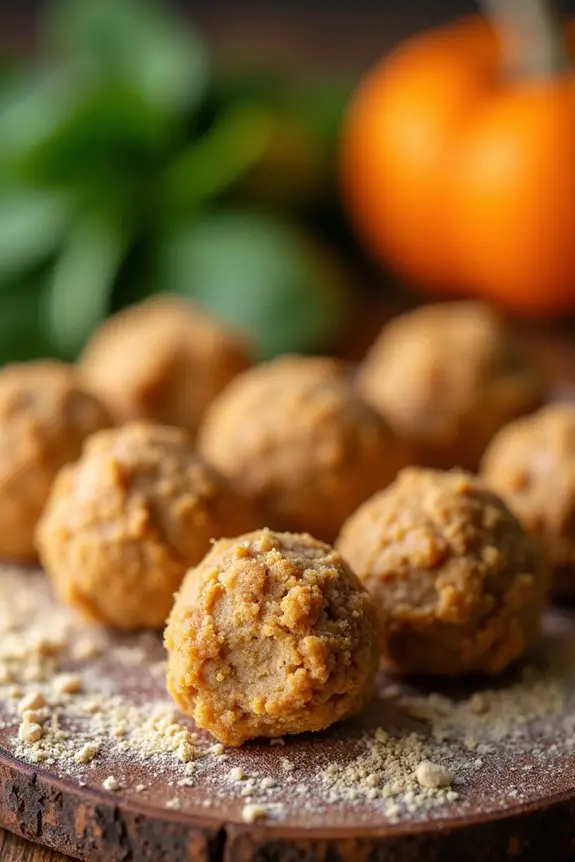
Let’s cook up some tasty Savory Spinach and Cheese Treats that your dog will absolutely drool over. You’ll need a few simple ingredients, and I promise you it’s easier than trying to get your pup to sit still for a photo. So, grab your apron, and let’s walk through the steps together—your furry friend deserves a snack that’s worth wagging their tail for.
Ingredients
Let’s whip up something tail-waggingly good for our furry friends.
These savory spinach and cheese treats aren’t just delicious but also packed with nutrients. Your pup will love munching on these goodies, and you’ll feel great knowing they’re made from wholesome ingredients.
So, let’s gather what we need:
- 1 cup whole wheat flour
- ½ cup spinach, finely chopped (fresh or frozen works!)
- ½ cup shredded cheese (cheddar or mozzarella are stellar choices)
- 1 egg, beaten
- ¼ cup low-sodium chicken or vegetable broth
And there you have it!
These simple ingredients come together to create a treat that will have your pooch drooling in anticipation.
Now, I don’t know about you, but if I could just reach into the mixer and grab a handful of these, I totally would (but let’s stick to giving them to the pups).
Happy baking!
Step by Step Instructions
- Preheat your oven to 350°F (175°C) to get it nice and warm while you prepare your treats.
- In a large bowl, combine 1 cup of whole wheat flour and 1 cup of oat flour. Whisk them together until they’re blended well.
- In a separate bowl, mix 1 cup of pureed spinach with ½ cup of shredded cheese (feel free to use your dog’s favorite cheese, but maybe steer clear of anything too strong or smelly).
- Add 1 extra-large egg to the spinach and cheese mixture, then whisk everything together until it’s smooth and creamy.
- Gradually fold the wet ingredients into the flour mixture, stirring gently until just combined.
- Don’t overmix—it should be a bit chunky.
- Lightly flour your work surface and turn the dough out. Knead it a few times until it comes together (don’t worry if it feels a bit sticky; that’s normal!).
- Roll out the dough to about ¼ inch thick. Use fun cookie cutters to make shapes—maybe a bone or a paw print.
- Place the treats on a baking sheet lined with parchment paper. Make sure they’re spread out a bit, so they don’t stick together while baking.
- Bake in your preheated oven for 20-25 minutes, or until they’re golden brown and firm to the touch.
- Once they’re out of the oven, let them cool completely before serving to your dog (Trust me; it’s hard if your pup is staring at you begging).
Optional Add-ons
When it comes to spoiling your pup, who doesn’t want to whip up something a little extra special?
You might consider adding some savory spinach and cheese to your treats. Just mix in a cup of cooked, chopped spinach and half a cup of shredded cheese.
Your dog will be drooling, and you might find yourself just a bit jealous of those tasty morsels.
Baking Time Adjustments
Baking peanut butter and banana dog treats is an adventure, but knowing how to adjust your baking time can make all the difference between a crunchy masterpiece and a chewy disaster.
Baking peanut butter and banana dog treats requires mastering baking time for perfect crunchiness or chewiness. Embrace the adventure!
Start by preheating your oven to 350°F. If you’ve mixed in extra goodies like oats or pumpkin, it might need a few more minutes. Keep an eye on those treats—once they’re golden brown around the edges, they’re usually good to go.
Do you ever pull out your treats, only to find they’re like mini bricks? I’ve been there, let me tell you—baking is a science, but it also requires a bit of gut feeling.
For chewier treats, reduce the time by 3-5 minutes. If they’re soft in the middle, don’t panic! They’ll harden up as they cool.
And remember, every oven is a little quirky. Baking’s part art and part trial and error; embrace the process.
Frequently Asked Questions
Can I Substitute Other Ingredients for Peanut Butter?
Yes, you can substitute other ingredients for peanut butter. Options like almond butter, pumpkin puree, or yogurt work well. Just verify they’re safe for your dog and adjust the consistency to maintain treat texture.
How Long Do These Treats Stay Fresh?
These treats generally stay fresh for about one to two weeks when stored in an airtight container at room temperature. If you refrigerate them, they can last up to a month or more.
Are These Treats Suitable for All Dog Breeds?
Yes, these treats are suitable for most dog breeds. However, always monitor your dog’s reaction and consult your vet if you’ve concerns about allergies or dietary restrictions. It’s important to guarantee they’re safe for your pet.
Can I Freeze the Treats for Later Use?
Yes, you can freeze the treats for later use! Just make sure to store them in an airtight container or freezer bag. Thaw them in the fridge before serving, and your dog will love them!
What if My Dog Has a Peanut Allergy?
If your dog has a peanut allergy, don’t use peanut butter. Instead, try other safe ingredients like pumpkin or sweet potato. Always check with your vet before introducing new treats to verify they’re safe.

Hi, I’m Ali Tarek, the founder of Animalsman. I’ve always been passionate about pets, especially dogs and cats, and I created this website to share practical tips, easy recipes, and helpful care advice for fellow pet lovers. My goal is to make pet care simple, enjoyable, and accessible for everyone. When I’m not writing or curating content, you’ll usually find me spending time with my furry friends or learning new ways to keep them happy and healthy.

